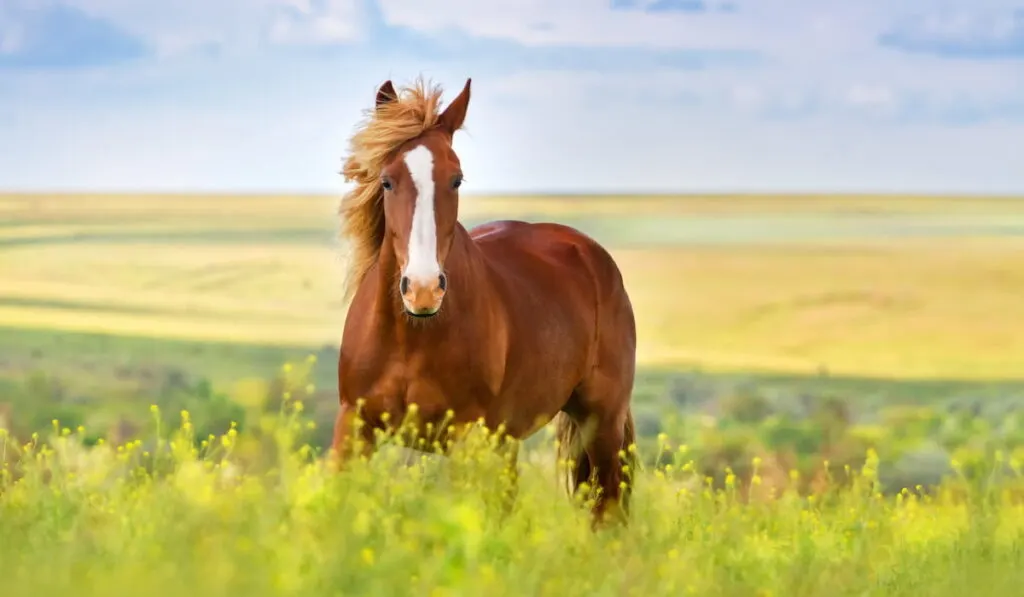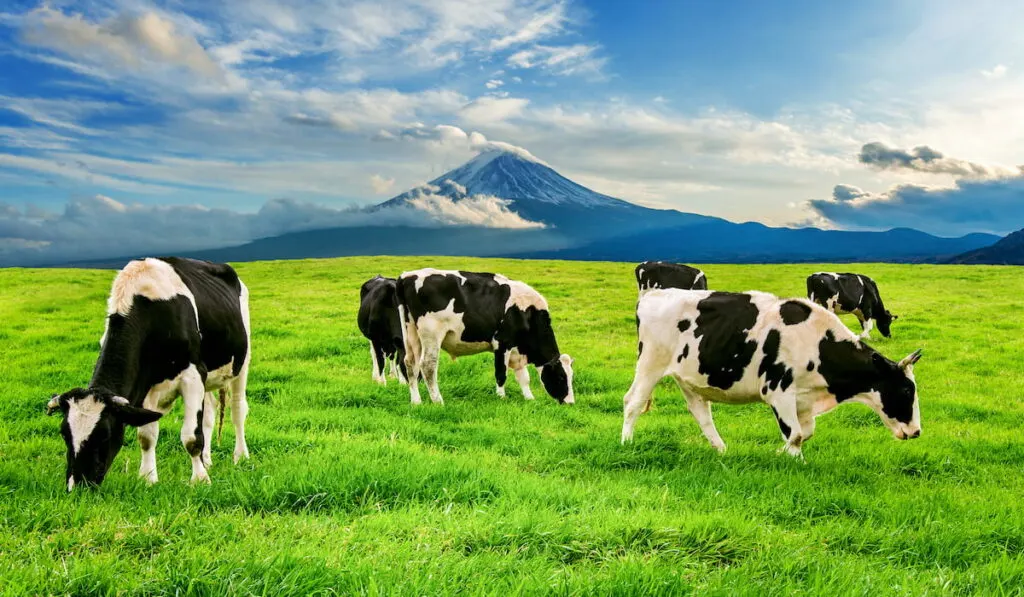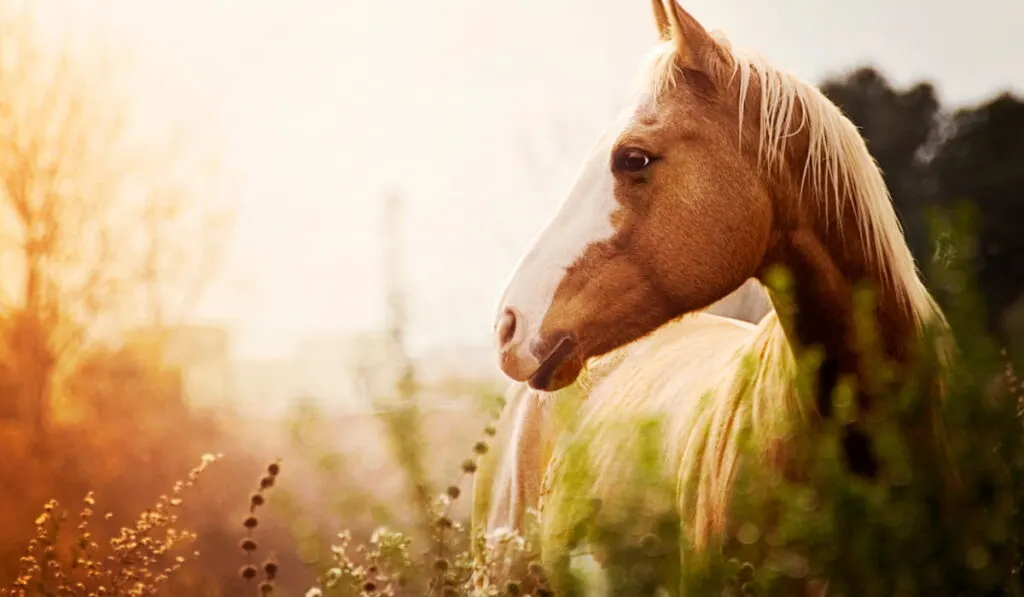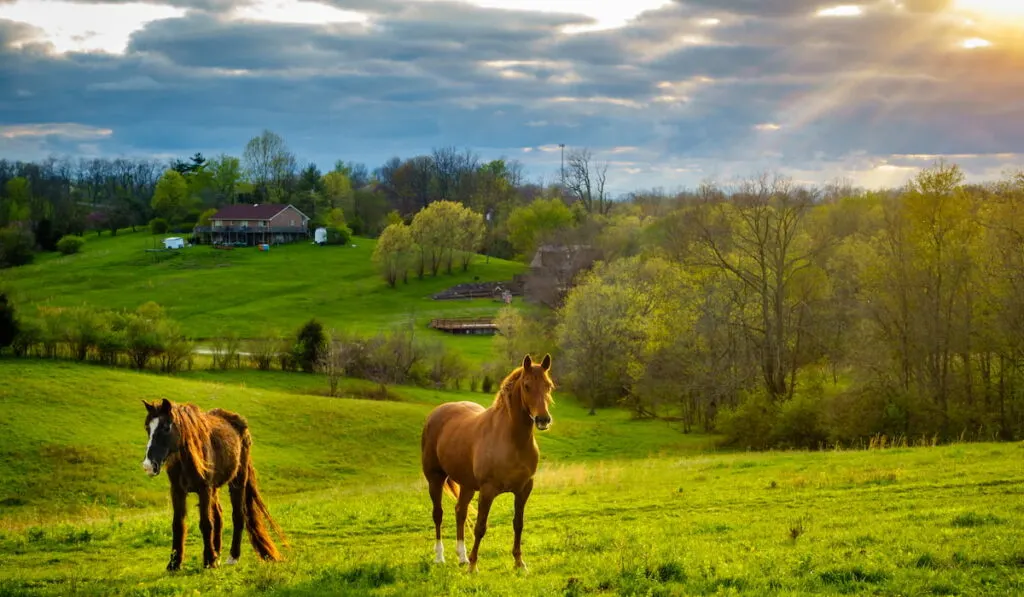Have you ever wondered if a horse was a ruminant animal or not? Many animals we are familiar with fit into the ruminant animal category including deer, cows, sheep and goats. Since many animals that survive on grassy forage tend to be ruminants, does that mean that horses are too?
Are horses ruminants? No! Horses are not ruminant animals. Ruminant animals have four compartments within their stomach that digest their food in stages. Horses only have one compartment in their stomach which means they do not fall within the ruminant category.

It is a common misconception that horses are ruminant animals like cows. Many people just assume that horses are ruminants since they eat grass. Unfortunately, eating grass is not one of the qualifiers for whether an animal is a ruminant or not.
If horse are not ruminant animals, then what are exactly are they? This question and more will be answered here!
Table of Contents
What is does being a Ruminant Animal Mean?
Animals that are ruminants have stomachs that are divided into four compartments, each of which performs a different function.
The most important compartment is the rumen, and it does most of the work. Lots of microorganisms live within the rumen and they work hard to help break down the forage that the animal eats.
When a ruminant animal eats some grass or other forage, they do not entirely chew up the food. Instead, they chew it a little and then swallow it. It then begins its digestive journey by traveling into the rumen compartment where it is partially digested and formed into balls of cud.
This cud is then pushed back up to the animal’s mouth, rechewed and then swallowed again. This helps the animal’s digestive system break down the cellulose that comprises the grass or forage they have eaten.

The rechewed food then follows a path through the other three compartments. These compartments are the reticulum, omasum, and then the regular stomach, the abomasum.
With their unique digestive systems, ruminant animals can eat and digestive foliage and vegetable components like cellulose that other animals – including humans – cannot properly digest.
| Examples of Ruminant Animals | Examples of Non-Ruminant Animals |
| Cows | Horses |
| Deer | Pigs |
| Sheep | Chickens |
| Goats | Dogs |
| Moose | Cats |
| Elk | Lions |
| Bison | Chimpanzees |
What Kind of Digestive system do Horses Have?
A horse has a stomach that contains only one compartment. They have a non-ruminant digestive system, but it is more complex than that of other non-ruminant animals.
The horse’s digestive system is comprised of a stomach, a small intestine and a large intestine. A horse’s stomach and small intestine function much like other monogastric animals like dogs, cats and pigs. This stomach and small intestine combination is referred to as the foregut.
The large intestine, however, is far more complex in size and function than that of other species. It is able to process cellulose, a substrate found in grass and vegetation that is impossible for humans to digest. The large intestine of a horse is referred to as their hindgut.
The hindgut – or large intestine – of a horse includes both the caecum and the colon. The caecum in a horse’s digestive system performs a unique function. It is basically a fermentation container that works to break down the forage, specifically the cellulose, that horses eat.
So, in simple terms, a horse chews its food completely the first time and swallows it.
That food then travels to their single-chambered stomach and later moves on to the small intestine. The small intestine pushes the food into the caecum, the initial compartment of the large intestine.
The food stays there for up to seven hours here where it is fermented and broken down even further. It then moves into colon to complete the digestive process. (source)

How is Equine Digestion Like That of Ruminants?
Horses do not have ruminant digestive systems, but they are able to process some of the same substrates that ruminant animals can.
Instead of using the rumen to process cellulose (a plant substance that is non-digestible for humans) horses can use their large intestines, specifically the cecum, to perform this function.
So, in a way, the cecum performs the same job as the rumen in ruminant animals. This is how horses can eat many of the same foods that ruminant animals can eat like grass and hay. (source)
Do Horses Chew Food Similarly to Ruminant Animals?
Although horses are not ruminants, they do tend to chew their food the same way that ruminant animals do. Cows, well-known ruminants, chew their food in systematic, rhythmic ways.
A study conducted by the University of Zurich and the ETH Zurich revealed that horses chew their food with the same rhythmic movements as ruminant animals. Horses cannot rechew their cud like ruminant animals do, but they do chew their food extensively in an effort to prepare it for the fermentation it will encounter in the upper part of their large intestine.
When researchers compared the amount of chewing performed by each animal, they found that both horses and cows effectively chewed their food the same way, even though cows were able to chew their food twice. (source)
What Animal has Four Stomachs?
Many people make the mistake of thinking that some animals, like cattle, have 4 separate stomachs. That is not necessarily true. There are no animals that have multiple, separated stomachs.
Some animals, like ruminants, have multiple compartments within their single stomach. Each of these compartments are connected to one another and exist within one single stomach.
All the compartments work together to perform different functions, but they are still all part of one stomach.
What are Pseudo-ruminants?
Pseudo-ruminant animals only have three compartments in their stomach instead of the four that ruminant animals have. Their stomach is divided into three sections called the C-1, C-2, and C-3. The C-1 part of the stomach is most similar to the rumen compartment in a ruminant animal.
A pseudo-ruminant’s body still processes food the same way that a ruminant animal does, using their foregut to process cellulose. They do not regurgitate their food and rechew like regular ruminant animals do which is another part of what makes them a pseudo-ruminant. The hippopotamus falls into this category. (source)
Were Prehistoric Horses Ruminants?
One of the first prehistoric horses to look similar to the modern day horse, the Merychippus horse, lived over 10 million years ago. The name Merychippus means “ruminant horse” in Greek. Many people mistakenly believe that this means that the Merychippus horse was a ruminant animal. This is not the case.
A ruminant animal today means that the animal has multiple stomach chambers and it has to chew its regurgitated cud. The prehistoric horse Merychippus was physiologically unable to do that, and they only had one chamber in their stomach.
The name Merychippus was given to this horse because it is the first known horse to be a true grazer, meaning that it survived mainly from grazing on grass. (source)

Final Thoughts
Horses are not ruminant animals, but they are able to process the same foods that ruminants can by using a different part of their digestive system.
Horses have only one chamber within their stomach compared to the four compartments that ruminant animals possess. Horses, despite not being able to regurgitate their food like cows can, are still able to digest grass and foliage effectively.
Horses may not be ruminant animals, but their digestive systems are just as unique and intriguing as ruminant animals, maybe even more so in some respects!
Source:
http://www.cattle.ca/assets/Uploads/232d540861/ruminants.pdf

